EntityFramework Code-First-------領域類配置之DataAnnotations
EF Code-First提供了一個可以用在領域類或其屬性上的DataAnnotation特性集合,DataAnnotation特性會覆蓋默認的EF約定。
DataAnnotation存在於兩個命名空間裏:
System.ComponentModel.DataAnnotations和System.ComponentModel.DataAnnotations.Schema
註意: DataAnnotations只提供了一部分的配置選項,全部的配置選項在Fluent API中。
System.ComponentModel.DataAnnotations 包含的特性:
| Attribute | 描述 |
|---|---|
| Key | 標記一個屬性,其將會在關系表中被映射成主鍵 |
| Timestamp | 標記一個屬性,其將會在數據庫中被映射成一個不為null的tiamestamp(時間戳)列 |
| ConcurrencyCheck | 這個屬性允許你標記一個或多個屬性,被標記的屬性將會在用戶編輯或刪除entity的時候進行並發檢查 |
| Required | 強制約束,該屬性必須有數據,不能為null(同樣適用MVC) |
| MinLength | 確保數組或字符串長度達到最小長度 |
| MaxLength | 數據庫中列的長度的最大值 |
| StringLength | 在數據字段中指定字符允許的最大長度和最小長度 |
System.ComponentModel.DataAnnotations.Schema 包含的特性:
| Attribute | 描述 |
|---|---|
| Table | 指定被映射的類在數據庫生成的表名 |
| Column | 指定被映射的屬性在表中的列名和數據類型 |
| Index | 在指定列上創建索引(僅EF6.1以上版本支持) |
| ForeignKey | 給導航屬性指定外鍵屬性 |
| NotMapped | 標記的屬性不會被映射到數據庫 |
| DatabaseGenerated | 指定的屬性將會映射成數據庫表中的計算列,所以這個屬性應是只讀的。也可以用在把屬性映射成標識列(自增長列) |
| InverseProperty | 當兩個類之間包含多重關系的時候,默認約定會排列組合他們的導航屬性組合並一一創建外鍵,InverseProperty可以標記實際的主外鍵關系,從而過濾掉因排列組合出來的無用外鍵 |
| ComplexType | 標記一個類為復雜類型 |
下面我們來詳細介紹各個特性:
1、Key:
Key特性應用在類的屬性上。Code-First默認約定將名稱是"Id"或者{類名}+"Id"的屬性創建為一個主鍵列,Key特性覆寫了默認約定,我們可以把任何想要成為的主鍵的屬性標記為Key而不管它是什麽名稱。
代碼如下:

using System.ComponentModel.DataAnnotations;
public class Student
{
public Student()
{
}
[Key]
public int StudentKey { get; set; }
public string StudentName { get; set; }
}

數據庫中,Students表中的StudentKey列被創建成了主鍵
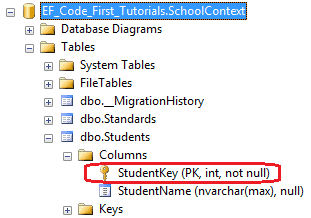
我們也可以用用Key特性和Column特性創建混合主鍵,如下代碼所示:

using System.ComponentModel.DataAnnotations;
public class Student
{
public Student()
{
}
[Key]
[Column(Order=1)]
public int StudentKey1 { get; set; }
[Key]
[Column(Order=2)]
public int StudentKey2 { get; set; }
public string StudentName { get; set; }
}

根據上面的代碼,在Students表中,創建出了混合主鍵StudentKey1和StudentKey2
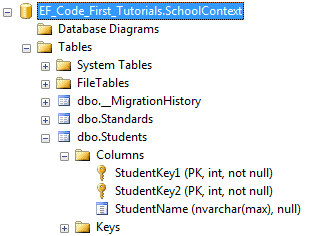
註意: 當Key特性應用在單整型類型的屬性上時,會將其創建為一個標識列,而混合鍵無論它是不是整型類型,都不會創建標識列。Key特性除了無符號整型(unsinged integers),可以應用在如string、datatime、decimal等任何數據類型上。
2、TimeStamp:
TimeStamp特性只能用在數據類型為byte array的屬性上,TimeStamp特性會在數據庫表中創建一個timestamp屬性的列,Code-First自動使用TimeStamp列進行並發檢查。
(關於並發檢查,可以參考Gyoung的筆記:Entity Framework 並發處理)
代碼如下:

using System.ComponentModel.DataAnnotations;
public class Student
{
public Student()
{
}
public int StudentKey { get; set; }
public string StudentName { get; set; }
[TimeStamp]
public byte[] RowVersion { get; set; }
}

再次強調,標記TimeStamp特性的屬性類型必須是byte數組。
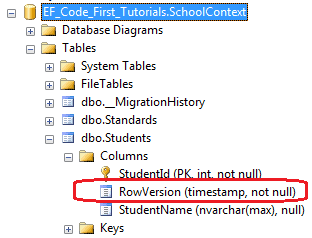
這樣,在數據庫Students表中就把RowVersion列創建成了timestamp(時間戳)
3、ConcurrencyCheck:
當EF對表執行update命令時,Code-First會把標記了ConcurrencyCheck特性的列中的值插入到SQL語句的“where”子句中來進行並發檢查。如下代碼:

using System.ComponentModel.DataAnnotations;
public class Student
{
public Student()
{
}
public int StudentId { get; set; }
[ConcurrencyCheck]
public string StudentName { get; set; }
}

如上所示,StudentName屬性上標記了ConcurrencyCheck特性,所以Code-First會在update命令中把StudentName列包含進去以進行樂觀並發檢查(有關樂觀並發和悲觀並發,上面Gyoung的筆記有介紹,這裏就不多討論)。如下代碼所示:
exec sp_executesql N‘UPDATE [dbo].[Students]
SET [StudentName] = @0
WHERE (([StudentId] = @1) AND ([StudentName] = @2))
‘,N‘@0 nvarchar(max) ,@1 int,@2 nvarchar(max) ‘,@0=N‘Steve‘,@1=1,@2=N‘Bill‘
go
註意:TimeStamp特性只能用在single byte數組屬性上,然而ConcurrencyCheck特性可以用在任何數量和任何數據類型的屬性上。
4、Required:
應用了Required特性的屬性,將會在數據庫表中創建一個不為null的列,需要留意的是,Required也是MVC的驗證特性。
代碼如下:

using System.ComponentModel.DataAnnotations;
public class Student
{
public Student()
{
}
public int StudentID { get; set; }
[Required]
public string StudentName { get; set; }
}

在數據庫中,StudentName列已經被創建成不為空。
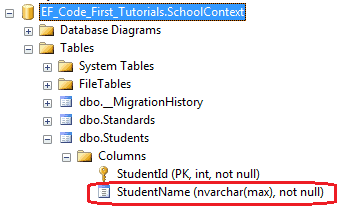
5、MaxLength & MinLength:
Maxlength特性用在String或array類型的屬性上,EF Code-First將會把列的大小設置成指定值。值得註意的是,Maxlength也是MVC的驗證特性。
代碼如下:

using System.ComponentModel.DataAnnotations;
public class Student
{
public Student()
{
}
public int StudentID { get; set; }
[MaxLength(50)]
public string StudentName { get; set; }
}

因為StudentName屬性被指定了[Maxlength(50)]特性,所以在數據庫中StudentName列被創建成nvarchar(50)。
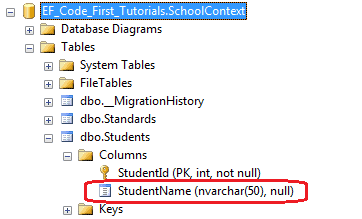
Entity Framework也會驗證被標記了MaxLength特性的屬性的值,如果該值大於被標記的最大值,EF將會拋出EntityValidationError。
MinLength:
MinLength特性是EF的一個驗證特性,其在數據庫模式中不起作用。如果我們對標記了MinLength特性的屬性賦值(string或者array),其長度小於指定的最小值,那麽EF仍然會拋出EntityValidationError。
MinLength特性可以和MaxLength特性一起使用,如下代碼所示:

using System.ComponentModel.DataAnnotations;
public class Student
{
public Student()
{
}
public int StudentID { get; set; }
[MaxLength(50),MinLength(2)]
public string StudentName { get; set; }
}

如上代碼所示,StudentName屬性取值指定了只能是2-50個字符長度之間。
6、StringLength:
StringLength應用在string類型的屬性上,EF Code-First將會用StringLength指定的長度設置列的大小。和Required以及Maxlength一樣,StringLength也是MVC的驗證特性。
看下面的代碼:

using System.ComponentModel.DataAnnotations;
public class Student
{
public Student()
{
}
public int StudentID { get; set; }
[StringLength(50)]
public string StudentName { get; set; }
}

根據代碼中StudentName屬性的[StringLength(50)]特性,在數據庫中,將會創建一個nvarchar(50)的列,如下所示:

同理,EF也將會驗證StringLength特性中的值,如果用戶輸入的值大於指定的長度,將會拋出EntityValidationError。
7、Table:
Table特性應用在類上,默認的Code-First約定將會創建一個和類名同名的表名,Table特性覆寫默認的約定,EF Code-First將會創建一個以Table特性裏指定的字符串為名稱的表。
代碼如下:

using System.ComponentModel.DataAnnotations.Schema;
[Table("StudentMaster")]
public class Student
{
public Student()
{
}
public int StudentID { get; set; }
public string StudentName { get; set; }
}

如上所示,Student類上應用了Table["StudentMaster"]特性,所以Code-First會覆寫默認的約定,創建一個名稱為StudentMaster的表名
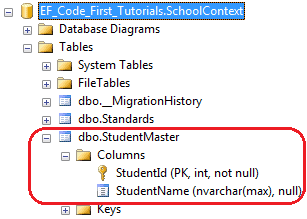
我們也可以用Table特性為表指定一個架構名,代碼如下所示:

using System.ComponentModel.DataAnnotations.Schema;
[Table("StudentMaster", Schema="Admin")]
public class Student
{
public Student()
{
}
public int StudentID { get; set; }
public string StudentName { get; set; }
}

數據庫如下,Code-First將會在Admin架構下創建一個StudentMaster表
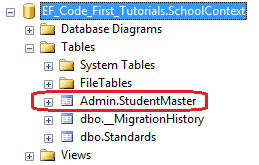
8、Column:
Column特性應用在類的屬性上,和Table特性一樣,如果不指定Column特性的值,將會默認創建和屬性同名的列,否則就會創建指定的值。
看如下代碼:

using System.ComponentModel.DataAnnotations.Schema;
public class Student
{
public Student()
{
}
public int StudentID { get; set; }
[Column("Name")]
public string StudentName { get; set; }
}

如上所示,Column["Name"]特性應用在StudentName屬性上,所以Code-First將會創建一個以"Name"為名的列來代替默認的"StudentName"列名。數據庫如下:
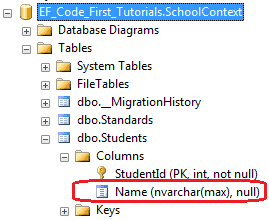
我們也可以使用Column特性為列指定排序(order)和類型(type),代碼如下:

using System.ComponentModel.DataAnnotations.Schema;
public class Student
{
public Student()
{
}
public int StudentID { get; set; }
[Column("Name", Order=1, TypeName="varchar")]
public string StudentName { get; set; }
}

上面的代碼在數據庫Students表中創建了一個屬性為varchar,排序第一的列Name
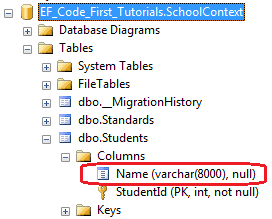
9、ForeignKey:
ForeignKey特性應用在類的屬性上。默認的Code-First約定預料外鍵屬性名與主鍵屬性名匹配,如下代碼:

public class Student
{
public Student()
{
}
public int StudentID { get; set; }
public string StudentName { get; set; }
//Foreign key for Standard
public int StandardId { get; set; }
public Standard Standard { get; set; }
}
public class Standard
{
public Standard()
{
}
public int StandardId { get; set; }
public string StandardName { get; set; }
public ICollection<Student> Students { get; set; }
}
}

如上代碼所示,Student類包含了外鍵屬性StandardId,其又是Standard類的主鍵屬性,這樣,Code-First將會在Students表中創建一個StandardId外鍵列。
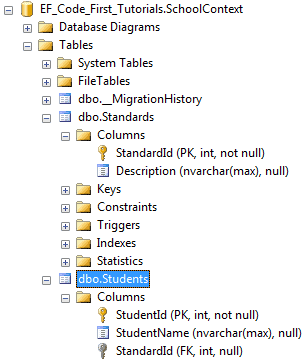
ForeignKey特性覆寫了默認約定,我們可以把外鍵屬性列設置成不同名稱,代碼如下:

public class Student
{
public Student()
{
}
public int StudentID { get; set; }
public string StudentName { get; set; }
//Foreign key for Standard
public int StandardRefId { get; set; }
[ForeignKey("StandardRefId")]
public Standard Standard { get; set; }
}
public class Standard
{
public Standard()
{
}
public int StandardId { get; set; }
public string StandardName { get; set; }
public ICollection<Student> Students { get; set; }
}

如上代碼所示,Student類包含了StandardRefId外鍵屬性,我們使用ForeignKey["StandardRefId"]特性指定在Standard導航屬性上,所以Code-First將會把StandardRefId作為外鍵,生成數據庫如下所示:
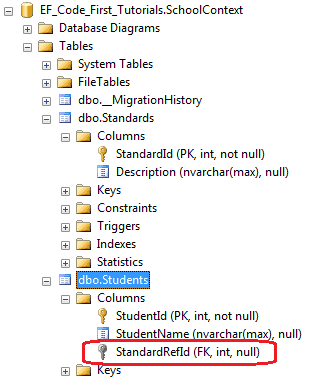
ForeignKey特性也可以用在外鍵屬性上,只要指定好它的導航屬性,即Standard屬性,如下所示:

public class Student
{
public Student()
{
}
public int StudentID { get; set; }
public string StudentName { get; set; }
//Foreign key for Standard
[ForeignKey("Standard")]
public int StandardRefId { get; set; }
public Standard Standard { get; set; }
}
public class Standard
{
public Standard()
{
}
public int StandardId { get; set; }
public string StandardName { get; set; }
public ICollection<Student> Students { get; set; }
}

這段代碼和上面把ForeignKey特性定義在Standard屬性上的效果是一樣的,在數據庫生成的Students表都創建了StandardRefId外鍵列。
10、NotMapped:
NotMapped特性用在類的屬性上,默認Code-First約定會為那些所有包含了getter和setter的屬性創建列,NotMapped可以覆寫默認的約定,讓那些標記了NotMapped特性的屬性不會在數據庫裏創建列。代碼如下:

using System.ComponentModel.DataAnnotations;
public class Student
{
public Student()
{
}
public int StudentId { get; set; }
public string StudentName { get; set; }
[NotMapped]
public int Age { get; set; }
}

如上代碼所示,NotMapped特性應用在Age屬性上,所以Code-First不會在Students表中創建Age列。
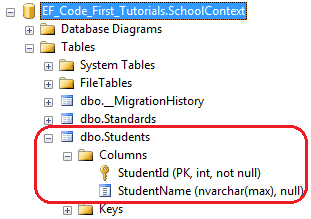
Code-First也不會為那些沒有getter和setter的屬性創建列,在下面代碼例子中,Code-First不會為FirstName和Age創建列。

using System.ComponentModel.DataAnnotations;
public class Student
{
public Student()
{
}
private int _age = 0;
public int StudentId { get; set; }
public string StudentName { get; set; }
public string FirstName { get{ return StudentName;} }
public string Age { set{ _age = value;} }
}

11、InverseProperty:
我們已經知道,如果類中沒有包含外鍵屬性,Code-First默認約定會創建一個{類名}_{主鍵}的外鍵列。當我們類與類之間有多個關系的時候,就可以使用InverseProperty特性。
代碼如下:

public class Student
{
public Student()
{
}
public int StudentID { get; set; }
public string StudentName { get; set; }
public Standard CurrentStandard { get; set; }
public Standard PreviousStandard { get; set; }
}
public class Standard
{
public Standard()
{
}
public int StandardId { get; set; }
public string StandardName { get; set; }
public ICollection<Student> CurrentStudents { get; set; }
public ICollection<Student> PreviousStudents { get; set; }
}
}

如上代碼所示,Student類包含了兩個Standard類的導航屬性,同樣的,Standard類包含了兩個Student類的集合導航屬性,Code-First將會為這種關系創建4個列。如下所示:
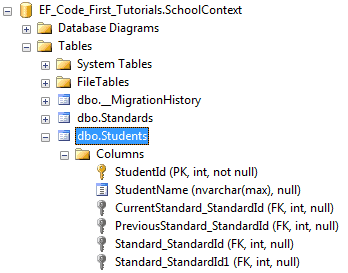
InverseProperty覆寫了這種默認約定並且指定對齊屬性,下面的代碼在Standard類中使用InverseProperty特性修復這個問題。

public class Student
{
public Student()
{
}
public int StudentID { get; set; }
public string StudentName { get; set; }
public Standard CurrentStandard { get; set; }
public Standard PreviousStandard { get; set; }
}
public class Standard
{
public Standard()
{
}
public int StandardId { get; set; }
public string StandardName { get; set; }
[InverseProperty("CurrentStandard")]
public ICollection<Student> CurrentStudents { get; set; }
[InverseProperty("PreviousStandard")]
public ICollection<Student> PreviousStudents { get; set; }
}
}

如上代碼所示,我們在CurrentStudents和PreviousStudents屬性上應用了InverseProperty特性,並且指定哪個Student類的引用屬性屬於它,所以現在,Code-First在Student表中僅僅會創建兩個外鍵了。如下圖所示:
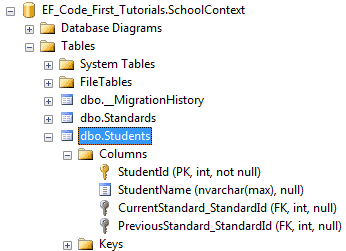
當然,如果你想改外鍵名稱,我們就給導航屬性加上ForeignKey特性,如下代碼所示:

public class Student
{
public Student()
{
}
public int StudentID { get; set; }
public string StudentName { get; set; }
public int CurrentStandardId { get; set; }
public int PreviousStandardId { get; set; }
[ForeignKey("CurrentStandardId")]
public Standard CurrentStandard { get; set; }
[ForeignKey("PreviousStandardId")]
public Standard PreviousStandard { get; set; }
}
public class Standard
{
public Standard()
{
}
public int StandardId { get; set; }
public string StandardName { get; set; }
[InverseProperty("CurrentStandard")]
public ICollection<Student> CurrentStudents { get; set; }
[InverseProperty("PreviousStandard")]
public ICollection<Student> PreviousStudents { get; set; }
}

上面的代碼將會創建出下面的數據庫表和列,我們可以看出,外鍵的名稱已經改變了。
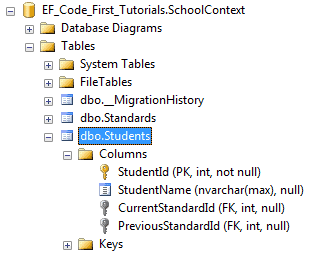
EntityFramework Code-First-------領域類配置之DataAnnotations
